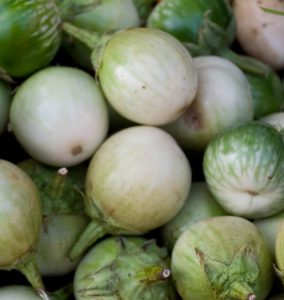Eggplant is generally underappreciated and underused in the American diet. It’s too bad; this versatile, very low-calorie vegetable can be used in a wide variety of delicious recipes. Eggplant is also packed with powerful antioxidants like nasunin that are good for your heart. Florida is one of the top eggplant-producing states in the U.S., so fresh eggplant is easy to find late fall through early summer here. Here are some tips on selecting, eating, and growing this healthy veggie.

Selecting eggplants to eat or grow
Different types of eggplant have varying textures, flavors, shapes, and colors. The following types are often available in local mainstream or specialty groceries, and farmers markets:
- American/Globe – large, bland, good for eggplant “steaks”.
- Italian – sweeter flavor, good for stuffing, roasting.
- Chinese – nearly seedless, which makes these one of my favorites (seeds can taste bitter); long, slender shape makes them great for slicing in stir fry or sautés.
- Japanese – smallish and slender, smooth texture, good for grilling.
- Indian – small fruits, great in stewed dishes.
- Thai – small, round, green, good in hot dishes, remove the seeds before using.
Select or harvest fruits that are smooth, shiny and smaller rather than maximum size. Overgrown eggplants have dull, tough skins, spongy insides, and can become bitter flavored. Eggplant tastes best when it’s very fresh and does not store well. Use within a couple days of purchase, or within a few days of harvest.
Grow your own
Eggplant is one of the easiest and prettiest vegetables to grow in the home garden. This vegetable can be planted in Central Florida in Sept.- Oct. for the fall growing season and in Feb.- Mar. for the spring growing season. Eggplant originates from tropical Asia, so it isn’t cold hardy, and will die if we have a freeze. Start seeds in small pots first and transplant when 6” tall, or for quicker harvest, just buy transplants. Eggplants need full sun and are well suited for container growing or raised beds. Eggplants are self-pollinating (so you can grow them in your pool screen), but fruit quality and quantity may improve with bee pollination. The most difficult factor in growing eggplant is trying to decide which types or varieties to grow! Here are a few heirloom varieties to consider. Dwarf varieties like ‘Patio Baby’ and ‘Fairytale’ are great for small spaces.
If spider mites appear, use a Horticultural Soap spray on the undersides of the leaves. Wear gloves when harvesting eggplant, some varieties have prickles on the stems and “caps”. To harvest, use hand pruners to snip the stem.
Eating eggplant

Try eggplant grilled, baked, stewed in curries, layered in veggie lasagna or ratatouille, or stuffed with rice, cheese or meat. Some of the world’s favorite eggplant recipes include baba ganoush (Middle-Eastern garlic dip heaven), moussaka (Mediterranean soul food casserole), or berenjena guisada (Caribbean stewed eggplant). If you’re new to cooking eggplant, start with easy recipes like Pasta with Eggplant and Tomato or Broiled Eggplant Salad from the Good and Cheap cookbook.
Don’t peel eggplant; the skin contains healthy stuff like anthocyanins (antioxidants). Eggplant absorbs vast amounts of cooking oil; avoid preparation methods like frying that just add calories. Avoid cooking eggplant in aluminum; it causes it to darken. If you grow too much eggplant to eat, preserve it: Slice it, steam or blanche it, then bag it and freeze it for use later.
For gardening, farming and food classes and information, contact the UF IFAS Extension-Osceola County: 321-697-3000.
 0
0
